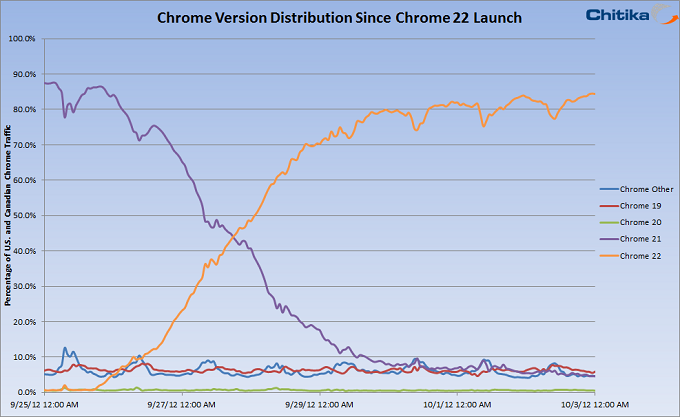On September 25th, 2012, Google unveiled the stable release of Chrome 22. The latest version of Google Chrome boasts new features such as Pointer Lock JavaScript API, which will support in-browser 3D gaming.
Within 24 hours of the release, usage of Chrome 22 peaked at 22%, a similar level of adoption to that of Chrome 21, which saw an adoption rate of 25% in its first full day on the market. These elevated adoption rates are likely supported by Chrome’s automatic update feature.
To quantify the rate of Chrome 22 adoption, Chitika Insights analyzed hundreds of millions of ad impressions from the Chitika Ad network, ranging from September 25th to October 3rd. The growth rate of Chrome 22 was then compared to total Chrome Web usage using a time series to illustrate the rate of adoption of the new browser. Two graphs depicting this trend can be seen below, including one from our new Chrome live tracker:
Since release, the vast majority of Chrome users have switched over to Chrome 22. Chrome 22 usage peaked in the last week at almost 85%. While this follows a similar adoption pattern to that of Chrome 21 – that version of Chrome took 10 days to reach the 85% marker. Certainly, Chrome is the leader of the pack when it comes to getting its users updated to the latest version. Research conducted by us and other sources have shown Firefox and Internet Explorer to possess a much more fragmented user base.


Chitika Insights – have you ever used Chrome browser?! Do you know that unlike the other browsers, Google one does not ask you if you want to update the version – but instead silently downloads the new version automatically and installs it next time when you restart the browser? Not only does it not ask you, it does not tell you it had been updated – and there is no easy way to stop that force-feeding with new version!
Whatever you are observing has nothing to do with user willingness – more with rate of Google servers confirming there is update for download when browser checks (Google can/do throttle down those to avoid effectively DoS attacking its own servers)
Interesting to see but not unexpected.